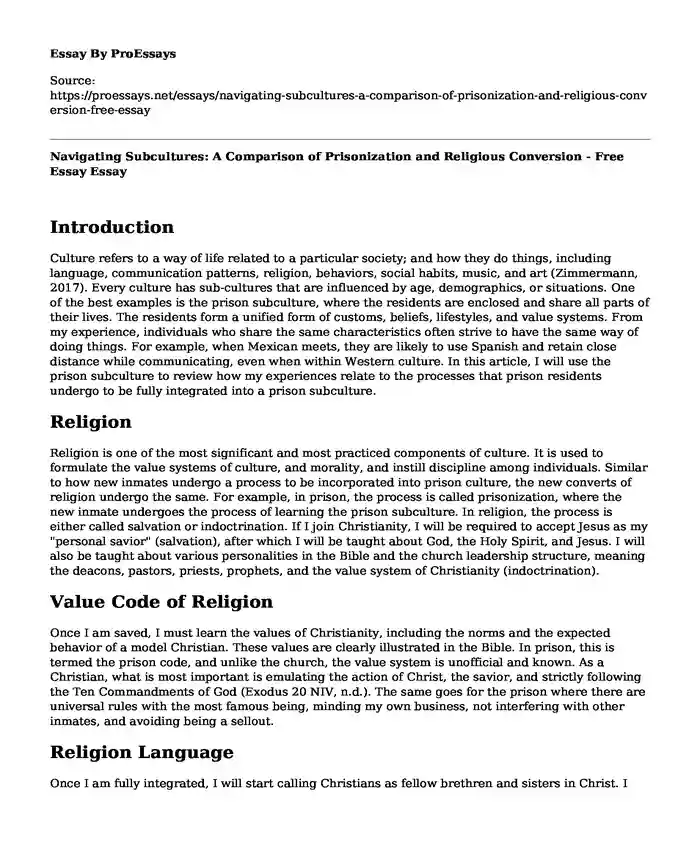Introduction
Culture refers to a way of life related to a particular society; and how they do things, including language, communication patterns, religion, behaviors, social habits, music, and art (Zimmermann, 2017). Every culture has sub-cultures that are influenced by age, demographics, or situations. One of the best examples is the prison subculture, where the residents are enclosed and share all parts of their lives. The residents form a unified form of customs, beliefs, lifestyles, and value systems. From my experience, individuals who share the same characteristics often strive to have the same way of doing things. For example, when Mexican meets, they are likely to use Spanish and retain close distance while communicating, even when within Western culture. In this article, I will use the prison subculture to review how my experiences relate to the processes that prison residents undergo to be fully integrated into a prison subculture.
Religion
Religion is one of the most significant and most practiced components of culture. It is used to formulate the value systems of culture, and morality, and instill discipline among individuals. Similar to how new inmates undergo a process to be incorporated into prison culture, the new converts of religion undergo the same. For example, in prison, the process is called prisonization, where the new inmate undergoes the process of learning the prison subculture. In religion, the process is either called salvation or indoctrination. If I join Christianity, I will be required to accept Jesus as my "personal savior" (salvation), after which I will be taught about God, the Holy Spirit, and Jesus. I will also be taught about various personalities in the Bible and the church leadership structure, meaning the deacons, pastors, priests, prophets, and the value system of Christianity (indoctrination).
Value Code of Religion
Once I am saved, I must learn the values of Christianity, including the norms and the expected behavior of a model Christian. These values are clearly illustrated in the Bible. In prison, this is termed the prison code, and unlike the church, the value system is unofficial and known. As a Christian, what is most important is emulating the action of Christ, the savior, and strictly following the Ten Commandments of God (Exodus 20 NIV, n.d.). The same goes for the prison where there are universal rules with the most famous being, minding my own business, not interfering with other inmates, and avoiding being a sellout.
Religion Language
Once I am fully integrated, I will start calling Christians as fellow brethren and sisters in Christ. I will refer to leaders as spiritual leaders, fathers, and the Holy Father. My language will be shaped in such a way that I must insert God or a Bible verse often. If I meet a long-lost friend, I will greet them and say, “We thank God for keeping us alive and making us meet again.” I will also refer to the wine offered in the church as the blood of Christ. Similarly, there are common names in prison-like cellie to indicate a cellmate and pruno to refer to homemade alcohol.
Religion Existence Justification
First, religion exists out of the human attempt to understand nature. Additionally, it is imported since the Christian model borrows from the Israelites' culture and has morphed worldwide. The same is evident in prison, where due to facing the same difficulties, the prisoners develop a subculture to cope; the deprivation model. Simultaneously, other cultural components might be imported from society or another prison; importation model.
My Understanding of the Article and Conclusion
First, the article is well structured and summarized articulately to reflect the prison subculture's main ideas. It captures all the main points in a simplified yet intricate manner to enable me to understand the content and relate it easily to my own experience. From the article, I have learned how a subculture is molded from an existing culture, for example, how a convicted member of the society will transform their way of doing things to those of the prison culture – prisonization. From that understanding, I could relate it to my journey through Christianity and how I changed some of the critical components like language and value systems to align with Christianity's values.
References
Exodus 20 NIV (n.d.). Bible Gateway. Www.Biblegateway.Com. Retrieved June 4, 2020, from https://www.biblegateway.com/passage/?search=Exodus%2020&version=NIV
Zimmermann, K., A. (2017, July 13). What Is Culture? | Definition of Culture. Live Science; Live Science. https://www.livescience.com/21478-what-is-culture-definition-of-culture.html
Cite this page
Navigating Subcultures: A Comparison of Prisonization and Religious Conversion - Free Essay. (2023, Dec 31). Retrieved from https://proessays.net/essays/navigating-subcultures-a-comparison-of-prisonization-and-religious-conversion-free-essay
If you are the original author of this essay and no longer wish to have it published on the ProEssays website, please click below to request its removal:
- Introduction Discussion of the Prevalent Types of Computer-Based Crimes
- Quantitative, Qualitative and Mixed Methods - Selecting a Research Approach
- Omniscience of God Essay
- Wilderness Programs for Juveniles Essay
- The Constitution of Medina - Essay Sample
- Essay on U.S. Judicial System: Ensuring People Obey Laws & Eliminating Conflicts
- Indigenous Women's Power & Authority Vs. French/British Settlers - Essay Sample







